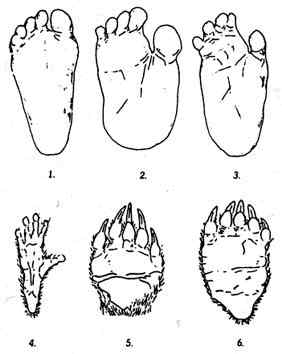That “Abominable Snowman” Mistake
Posted by: Loren Coleman on October 11th, 2011

I just heard a BBC News radio report (it sounded like the voice of Jon Downes) being quoted as saying that the original mistranslation that caused the mistake of “Abominable Snowman” was first published in the UK’s Daily Mail.
Just for the record, in case anyone else is asked, it wasn’t the Daily Mail initially, at least.
These unknown hairy hominoids of the Himalayas were not widely known to Western civilization until 1921. The events that transpired were set forth by a telegram sent from an expedition then in the Mt. Everest region.
At about 17,000 feet, members of the Royal Geographical Society’s 1921 Mount Everest Reconnaissance Expedition reported watching through binoculars a number of dark moving forms on a snowfield above them. After much effort, the expedition made their way to the snowfield at 21,000 feet, and found a large number of footprints, “three times those of normal humans” in size. Team leader Lieutenant-Colonel Charles Kenneth Howard-Bury DSO, DL, JP (15 August 1881 – 20 September 1963) thought they were those of a “loping grey wolf,” [*see below] but his Sherpa guides attributed them to a wild man of the snows, which they called “metoh kangmi,” a generic Nepalese term for snow creatures, apparently.
When the expedition returned to India, the porters were interviewed by a freelance journalist named Henry Newman, then a reporter at the Calcutta Statesman. He is responsible for the term “Abominable Snowman,” as he mistranslated the word “metoh” to mean “filthy,” which he then exaggerated to “abominable.”
The telegram to India was sent forth with the word metch kangmi, as it was noted in the dispatch and was translated, incorrectly, by Newman as Tibetan for “Abominable Snowman.”
There were several layers of confusion. The first was the use of metoh in the first place. It should have been meh-teh, meaning man-beast. The second was that it was mistakenly transcribed by an Indian telegraphist as metch, instead of metoh. And lastly, that the term was Nepalese, and was translated as Tibetan.
Later Newman wrote in a letter to The Times, “The whole story seemed such a joyous creation I sent it to one or two newspapers.”
One insightful observer of the field, Ralph Izzard in his 1955 book, The Abominable Snowman Adventure, wrote that “whatever effect Mr. Newman intended, from 1921 onwards the Yeti – or whatever various native populations choose to call it – became saddled with the description ‘Abominable Snowman,’ an appellation which can only appeal more to the music-hall mind than to mammologists, a fact which has seriously handicapped earnest seekers of the truth.”
The whole thing is such a mess, there is no need for any of us to blame the poor Daily Mail too.
+++
*The Himalayan mountains are the home to three distinctive kinds of wolves: the gray wolf, Canis lupus; the Tibetan wolf, Canis lupus chanco; and the Himalayan wolf, Canis himalayensis. The relative sizes of each population in the region are small. The Himalayan wolf was only first described as a separate species in 2007, and in April 2009, the Latin binom Canis himalayensis was proposed as nomenclatural and taxonomic change by the Nomenclature Specialist on the CITES Animals Committee.
About Loren Coleman
Loren Coleman is one of the world’s leading cryptozoologists, some say “the” leading living cryptozoologist. Certainly, he is acknowledged as the current living American researcher and writer who has most popularized cryptozoology in the late 20th and early 21st centuries.
Starting his fieldwork and investigations in 1960, after traveling and trekking extensively in pursuit of cryptozoological mysteries, Coleman began writing to share his experiences in 1969. An honorary member of Ivan T. Sanderson’s Society for the Investigation of the Unexplained in the 1970s, Coleman has been bestowed with similar honorary memberships of the North Idaho College Cryptozoology Club in 1983, and in subsequent years, that of the British Columbia Scientific Cryptozoology Club, CryptoSafari International, and other international organizations. He was also a Life Member and Benefactor of the International Society of Cryptozoology (now-defunct).
Loren Coleman’s daily blog, as a member of the Cryptomundo Team, served as an ongoing avenue of communication for the ever-growing body of cryptozoo news from 2005 through 2013. He returned as an infrequent contributor beginning Halloween week of 2015.
Coleman is the founder in 2003, and current director of the International Cryptozoology Museum in Portland, Maine.










In a haste to be the first, humans are often messy and ill prepared…
Loren, pardon my asking, but was this taken mostly from Ivan T. Sanderson’s book? I have my first edition hardback of that book carefully packed away or I would look it up myself…. The drawings of different feet brought it to mind first, but then reading the article itself made me think even more of his book.